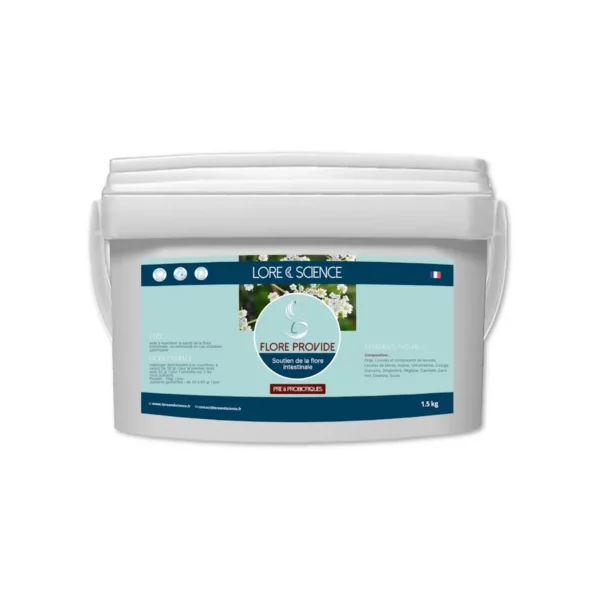A horse's well-being and performance depend to a large extent on its muscular health. Equine muscles are subjected to a great deal of stress, whether duringintense effort, competition or simplydaily exercise. Muscle recovery is a crucial component in managing your equine's overall health. The specialists at Lore & Science tell you all about the best ways to optimize your horse's muscle recovery.
Better muscle recovery for improved performance
Just like human athletes, equine muscles require an inescapable period of recovery after being put through their paces. Although discreet, muscle recovery is a complex set of physiological processes. Its primary objective is to repair tissues that have been damaged during exercise. At the same time, it eliminates the metabolic waste products that have accumulated during exercise, helping to cleanse and revitalize muscle tissue. What's more, this recovery phase plays a fundamental role in re-establishing the muscular balance that is essential to the horse's continued performance.
The importance of muscle recovery cannot be underestimated, especially for athletic horses. It is the cornerstone of injury prevention, preventing fatigued muscles from becoming vulnerable to the excessive stresses that can lead to injury. This recovery period is also an essential element in maintaining long-term performance, as it enables the horse to retain optimum muscle strength and the ability to respond to physical demands with vigour. More broadly, it is intrinsically linked to the horse's general well-being, promoting physical comfort and contributing to overall health.
How can you help your horse's muscular recovery after a competition or intense effort?
Events such as competitions and horse racing lead to lactic acid production and cellular oxidation in the horse athlete. In the long term, this can have serious consequences. Fortunately, it is possible to speed up the recovery process.
Incorporating stretching and equine massage
For example, we recommend incorporating stretching and massage into your post-competition recovery routine. Stretching helps to release muscle tension built up during exercise, improve flexibility and prevent injury. They are particularly beneficial after intensive training sessions or competitions. Stretching can target specific muscle groups, such as the hind legs, shoulders or neck, depending on your horse's needs. Well-executed massages, on the other hand, can relieve muscle knots, stimulate blood circulation, promote the elimination of metabolic waste products and help prevent muscle soreness. It's important to learn proper equine massage techniques from an experienced professional or certified equine therapist, as the wrong massage can cause more harm than good.
Use 100% natural food supplements
In addition, certain phytotherapy products, specially formulated for competitive equines, can play an essential role in the recovery process. Among these supplements, Acidless stands out as a valuable ally for horses that have taken part in demanding events such as horse racing.
This phytotherapy food supplement is designed to promote healthy, rapid recovery after intense effort. It has been specially formulated to helpeliminate lactic acids and free radicals produced during sustained physical performance. These substances, which can accumulate in muscles after intense exercise, are responsible for feelings of fatigue and muscle stiffness. Acidless intervenes by facilitating the elimination of these undesirable metabolites, enabling the horse to recover more effectively.
-

 Acidless - Post-exertion recovery for horses29,90 € - 79,90 €
Acidless - Post-exertion recovery for horses29,90 € - 79,90 €
How to optimize muscle recovery in horses on a daily basis?
Athlete horses aren't the only ones concerned by the need for good muscle recovery. For working horses and mares, as well as for everyday use, there are a number of key measures to be implemented.
One of the first keys is, as is often the case, an appropriate diet. Protein, in particular, is essential for the regeneration of muscle tissue. Make sure your horse's diet provides quality nutrients to support this recovery. Similarly, adequate hydration is crucial to avoid muscle cramps and exhaustion. Make sure your horse always has access to clean, fresh water.
The second pillar of equine muscle recovery is, of course, rest. After an intense and demanding effort, it's imperative to give your horse a period dedicated to recovery. Within this recovery interval, your horse can regenerate its energy reserves, repair muscle micro-injuries and restore its physiological balance.
However, it's not enough to simply allow the horse to rest. The environment in which this rest takes place is of crucial importance. A calm, comfortable environment is the key to your horse's complete muscular relaxation. This means creating a space where he can escape stressful stimuli and distractions. A clean, well-ventilated and sufficiently spacious stall is often the best choice for providing your horse with the ideal place to recharge his batteries. Make sure the stall has a soft, comfortable bedding to encourage restful sleep.
If you follow these few tips, you'll soon notice that your horse's muscles recover more quickly. You'll also prevent a number of lesions and injuries that can be caused by over-fatigue. Of course, it's essential to adapt these practices to your horse's individual needs, activity level and sensitivity. A gentle, progressive approach is the key to ensuring that your horse or mare benefits fully from these muscle-recovery techniques.
Share your experience or questions with us in the comments ↓














